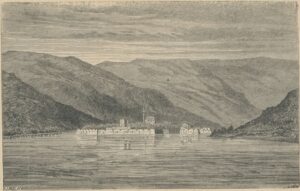Le Tour du Monde. Auguste Dieudonne Lancelot in the Romanian Countries

Le Tour du Monde. Noveau Journal des Voyagers He appeared in Paris in January 1860, under the direction of the French publicist Edouard Charton.
The purpose of these publications was to print the stories of the French explorers around the world in a manner of scientific popularization that evoke the exotic spaces they saw but also to describe them geographically. In order for readers experience to be complete, the publication had illustrations made by famous artists. Their responsibility was of aesthetic invoice, remaining loyal to the artistic band they had, but also to the reality encountered, bringing in their engravings as accurate reproductions of the spaces, people and cultures with which they interact. Today, the documentary value of their works prevails in front of the artistic one. Among the spaces between the pages of the journal are: Tunisia, Central Africa, Valley Zambeze River (Zambia, Angola, Botswana, Zimbabwe, Mozambic), Senegal, Australia, Italy, Romanian Countries, France, Serbia, Austro-Hungarian Empire, Sicily, Turkistan (Kazakhstan), French Guyana, etc.
Every six months, these materials were gathered in a volume and sold as such. Their reports were thus preserved in the long term and were not only browsed a few days, as with a normal newspaper. Among these stories, the reports about the Romanian space illustrated by a young French artist appear. His name is Auguste Dieudonne Lancelot (1823-1895). He traveled, in 1860, incognito through villages and cities, registering the image of a society that passes from orientalism to Westernism, from the precarious world of villages to noble buildings in cities, types of peasants and townspeople. The approach had to be made by Lancelot and the historian Jean Victor Duruy (1811-1894), but for unknown reasons, in Vienna only lancelot on the Romanian countries. Thus the first set of works appears in Le Tour du Monde In 1863, next to the story of Duruy, and the following appeared in the numbers of 1865, 1866 and 1868 without its contribution, Lancelot assuming both the texts and the illustrations of the articles.
In 1863, Duruy reviews the journey made by the two from Paris to Vienna. According to his articles published between 1865-1868, Lancelot went through: Paris-Budapest-Semlin (the current Zemun neighborhood in Belgrade)-Belgrade-Orșova-Vidin-Rahova-Nicopole-Ruse-Giurgiu-Bucharest-Găești-Pitești-Curtea de Argeș-Cozia-Vâlcea Cioclovina – Arama Baia – Turnu Severin – Orșova – Mehadia – Timișoara. Therefore, through the maritime journey on the Danube, it crosses the Austro-Hungarian Empire, Serbia, northern Bulgaria, Wallachia and Banat, the last documented stop being in the city of Bega.
On the Danube, he admires and plays the medieval fortresses on both banks of the river, the Danube boilers, Ada Kaleh Island, the remains of Trajan’s bridge, Traian’s Road. From Giurgiu to Bucharest, he manages to capture the daily activities of the Wallachians: the transport of carriages, the peasants’ Sundays in holiday clothes, the screws with their business. And in the capital, it stops on the Inn of Manuc, the houses with Ottoman architecture, the medieval churches. In Bucharest, it reaches, through the recommendation written by Duruy, to be hosted by Prince Grigore Basarab Brâncoveanu, the son of Mr. Gheorghe Bibescu, who was the student of the French historian in his years in France. Through his goodwill, Lancelot receives a roadmower, the secretary of the prince he only calls through the initials MD the two embark on the terrestrial journey from Bucharest Via Argeș to Timișoara and visits the churches and emblematic monasteries from the south of Wallachia: from the Court of Argeș, etc. Here it captures the architecture of the buildings, but also the people he meets. In this part of the trip, it captures some emblematic portraits of monks, nuns, peasants and 100 -year -old from Cioclovina village.
By the nature of his journey, Lancelot contacts the lower blankets of the society and very little with the elites, which is why his images capture a more difficult reality in plastic art, which art history George Oprescu called « The true life of the people, full of qualities, but badly governed, intelligent, equipped for art, good, but harassed with evil through so many centuries of Turkish, apathetic domination, then and suffering everything without reacting, even when they were shouted. « .

exhibition Le Tour du Monde. Auguste Dieudonne Lancelot in countries Romanian, organized at the Suțu Palace between April and September 2025, continues the series of European engraving exhibitions that treat the Romanian space in the 19th century in the effort to recover, in the most complete way, the visual sources left behind by artists who traveled to the Romanian countries. Thus, they are in the literary tendencies of the time, as an illustration for materials of journalistic character, engraving towards the middle of this century visual primary source for different articles in newspapers. Therefore, the reference engraving in this case behaves as a historical source contributing to the reflection of the image of the Romanian society, but also of the geographical observation with sypecific elements. Of the 126 works signed by Lancelot, which are in the heritage of the Bucharest Municipality Museum, this exhibition proposes 50 pieces in order to illustrate the artist’s journey into the Romanian space and the way in which the urban and private spaces, the architectural and natural monuments, the people and their daily activities are reflected.
Curator: dr. Nicoleta Bădilă – Museographer, Systematic Archeology and History Section










